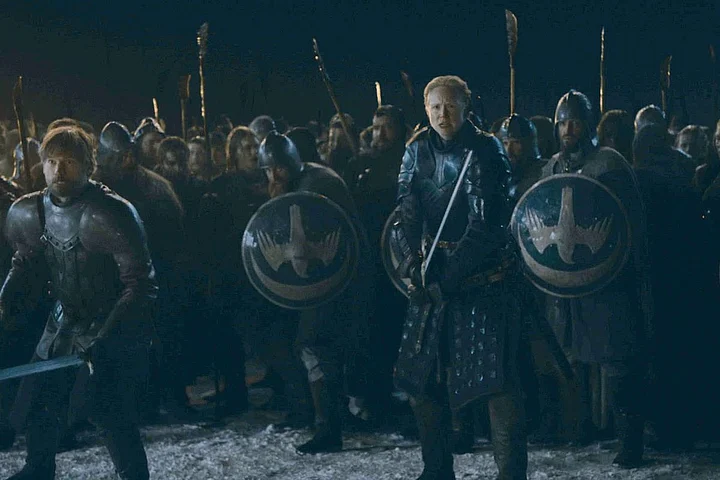Phew!
That was a lot to take in.
Battle of Winterfell from Game of Thrones final season’s episode 3 (The Long Night) would easily go down in the history of fantasy TV as the most thrilling and epic 90 minutes ever. For its sheer choreographically marvel.
Every bit of action was shocking, chilling and felt very real: even with mid air dragon fights, giant wights destroying Castle of Winterfell, and dead Starks coming to life in the Crypts.
Fantasy lovers got what they have been craving for since the final season of the show premiered - action and deaths, lots and lots of gory, gruesome deaths. While the show-makers had set themselves up with the fan’s expectations, no amount of theorizing could come close to witness what just went down at Winterfell.
Game of Thrones, the epic fantasy saga from HBO, has a long standing history of aweing its fans with fantastic battle sequences: Battle of Blackwaters, Battle of Castle Black, and Battle of Bastards have raised the bar quite high.
Therefore the expectations from the 8th and the final season’s key face-off between the White Walkers and our heroes at Winterfell was naturally quite high.
Especially when HBO boasted of thrilling fans with the longest ever choreographed battle sequence in TV or movies history, the earlier record being set by The Lord Of The Rings’ Battle of Helm's Deep in Lord of the Rings: The Two Towers.
“This final face-off between the Army of the Dead and the army of the living is completely unprecedented and relentless and a mixture of genres even within the battle. There are sequences built within sequences built within sequences. David and Dan [wrote] an amazing puzzle and Miguel came in and took it apart and put it together again. It’s been exhausting but I think it will blow everybody away.”Co-executive producer Bryan Cogman to Entertainment Weekly
The parallels to the epic battle in the LOTR universe were heavily discussed among fans on th Internet even before the episode aired. We already got what felt like a small homage to LOTR with the song Jenny of Oldstones at the end of episode 2, which was very similar to the song 'Home is Behind' sung by Pippin in Return of the King, in the buildup to Faramir's ill-fated charge against the forces of evil in Osgiliath.
Interestingly, director Miguel Sapochnik actually went back to that iconic battle sequence to figure out how to film this clash between the White Walkers and their army of undead, and the forces of Daenerys and Jon.
To give us a Battle sequence of such epic scale naturally took a lot of effort on the production part. The showmakers shared via multiple interviews that the filming the Battle of Winterfell took eleven weeks of shooting at night, and was quite the exhausting exercise for hundreds of crew members involved in the shooting.
That’s about 750 people working all night long for nearly three months in the middle of open rural countryside in temperatures as low as 30s.
If you are caught up with the episode you’d know that the scenes were shot under icy rain, bone shattering wind, and a cloud of horse manure odor and smoke. it won’t be wrong to say that shooting the battle sequence off-screen was every bit as grueling as our character’s face-off with the Night King onscreen.
In fact Maissie Williams, AKA Arya Stark who plays a key role in how the Battle of Winterfell turns out, had looked forward to finally being part of a Thrones battle sequence, until she realised how tough it was.
“Nothing can prepare you for how physically draining it is. It’s night after night, and again and again, and it just doesn’t stop. You can’t get sick, and you have to look out for yourself because there’s so much to do that nobody else can do… there are moments you’re just broken as a human and just want to cry.Maissei Williams, Actor, Game of Thrones, to Entertainment Weekly
Other actors on the set would second her thoughts.
While actors did some time off and relief, there was no respite for the crew members onboard.
Part of Sapochnik’s strategy was to get actors actors to fill gaps in storyline whenever the camera panned to another actor. As the actor who plays Samwell Tarly explains in this article: “We may not have seen Sam for 10 minutes but something has happened to Sam in those 10 minutes — you’ve been fighting, or you’ve been running, or you’ve been hiding. How has your story developed? You have to hold in your mind what’s happened since we saw you last.”
In fact, to keep actors motivated the director would catch them off-guard with the questions like - ‘why are you here?’ or ‘ what are you fighting for?’. It was to keep the actors and their characters focused.
With an epic episode like The Long Night, which almost felt like a season finale itself - showmakers have to pressure to deliver something even better or atleast that meets this standard for the actual finale that would air on May 19.
How did you like this episode of Game of Thrones? Let us know in the comments.
(Inputs from Entertainment Weekly)
